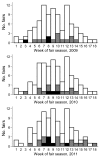Subclinical influenza virus A infections in pigs exhibited at agricultural fairs, Ohio, USA, 2009-2011
- PMID: 23171654
- PMCID: PMC3557874
- DOI: 10.3201/eid1812.121116
Subclinical influenza virus A infections in pigs exhibited at agricultural fairs, Ohio, USA, 2009-2011
Abstract
Agricultural fairs are associated with bidirectional, interspecies transmission of influenza virus A between humans and pigs. We examined pigs exhibited at agricultural fairs in Ohio during 2009-2011 for signs of influenza-like illness and collected nasal swab specimens from a representative subset of these animals. Influenza virus A was recovered from pigs at 12/53 (22.6%) fairs during the 3-year sampling period. Pigs at 10/12 (83.3%) fairs from which influenza virus A was recovered did not show signs of influenza-like illness. Hemagglutinin, neuraminidase, and matrix gene combinations of the isolates were consistent with influenza virus A concurrently circulating among swine herds in the United States. Subclinical influenza virus A infections in pigs at agricultural fairs may pose a risk to human health and create challenges for passive surveillance programs for influenza virus A in swine herds.
Figures

References
-
- Olsen C, Brown I, Easterday B, Van Reeth K. Swine influenza. In: Straw BE, editor. Diseases of swine, 9th ed. Ames (IA): Blackwell Publishing; 2006.
Publication types
MeSH terms
Substances
Grants and funding
LinkOut - more resources
Full Text Sources
